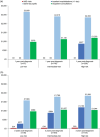Association of risk assessment at diagnosis with healthcare resource utilization and health-related quality of life outcomes in pulmonary arterial hypertension
- PMID: 38979095
- PMCID: PMC11229026
- DOI: 10.1002/pul2.12399
Association of risk assessment at diagnosis with healthcare resource utilization and health-related quality of life outcomes in pulmonary arterial hypertension
Abstract
We aimed to describe the clinical characteristics, healthcare resource utilization (HCRU) and costs, health-related quality of life (HRQoL), and survival for patients with pulmonary arterial hypertension (PAH), stratified by 1-year mortality risk at diagnosis. Adults diagnosed with PAH at the Sheffield Pulmonary Vascular Disease Unit between 2012 and 2019 were included. Patients were categorized as low, intermediate, or high risk for 1-year mortality at diagnosis. Demographics, clinical characteristics, comorbidities, HCRU, costs, HRQoL, and survival were analyzed. Overall, 1717 patients were included: 72 (5%) at low risk, 941 (62%) at intermediate risk, and 496 (33%) at high risk. Low-risk patients had lower HCRU prediagnosis and 1-year postdiagnosis than intermediate- or high-risk patients. Postdiagnosis, there were significant changes in HCRU, particularly inpatient hospitalizations and accident and emergency (A&E) visits among high-risk patients. At 3 years postdiagnosis, HCRU for all measures was similar across risk groups. Low-risk patients had lower EmPHasis-10 scores (indicating better HRQoL) at diagnosis and at 1-year follow-up compared with intermediate- and high-risk patients; only the score in the high-risk group improved. Median overall survival decreased as risk category increased in analyzed subgroups. Low-risk status was associated with better 1-year survival and HRQoL compared with intermediate- and high-risk patients. HCRU decreased in high-risk patients postdiagnosis, with the most marked reduction in A&E admissions. The pattern of decreased per-patient inpatient hospitalizations and A&E visits at 3 years postdiagnosis suggests that a diagnosis of PAH helps to decrease HCRU in areas that are key drivers of costs.
Keywords: healthcare resource utilization; health‐related quality of life; pulmonary arterial hypertension; real‐world evidence; risk assessment.
© 2024 Actelion Pharmaceuticals Ltd and The Author(s). Pulmonary Circulation published by John Wiley & Sons Ltd on behalf of Pulmonary Vascular Research Institute.
Conflict of interest statement
Allan Lawrie is supported by a British Heart Foundation Senior Basic Science Research Fellowship (FS/18/52/33808) and has received honoraria and funding from Janssen Pharmaceuticals to attend scientific meetings. Amélie Beaudet, Audrey Muller, Rafael Sauter, and Nadia Pillai are employees of Actelion Pharmaceuticals Ltd. Amélie Beaudet and Audrey Muller own stock in Johnson & Johnson. Neil Hamilton has received honoraria payments from Janssen Pharmaceuticals, Vifor Pharmaceuticals, and MSD. David G. Kiely has received grants from Janssen Pharmaceuticals and Ferrer; consulting fees from Janssen Pharmaceuticals, MSD, Ferrer, Altavant, and United Therapeutics; honoraria from Janssen Pharmaceuticals, MSD, Ferrer, and United Therapeutics; funding from Janssen Pharmaceuticals, MSD, and Ferrer to attend scientific meetings; has participated in a Data Safety Monitoring Board or Advisory Board for Janssen Pharmaceuticals and MSD; serves on the Specialist Respiratory Clinical Reference Group (unpaid) and as the UK National Audit Chair. Steven Wood has received grants from Janssen Pharmaceuticals in support of the current study. The remaining authors declare no conflict of interest.
Figures





References
-
- Humbert M, Kovacs G, Hoeper MM, Badagliacca R, Berger RMF, Brida M, Carlsen J, Coats AJS, Escribano‐Subias P, Ferrari P, Ferreira DS, Ghofrani HA, Giannakoulas G, Kiely DG, Mayer E, Meszaros G, Nagavci B, Olsson KM, Pepke‐Zaba J, Quint JK, Rådegran G, Simonneau G, Sitbon O, Tonia T, Toshner M, Vachiery JL, Vonk Noordegraaf A, Delcroix M, Rosenkranz S, Schwerzmann M, Dinh‐Xuan AT, Bush A, Abdelhamid M, Aboyans V, Arbustini E, Asteggiano R, Barberà JA, Beghetti M, Čelutkienė J, Cikes M, Condliffe R, de Man F, Falk V, Fauchier L, Gaine S, Galié N, Gin‐Sing W, Granton J, Grünig E, Hassoun PM, Hellemons M, Jaarsma T, Kjellström B, Klok FA, Konradi A, Koskinas KC, Kotecha D, Lang I, Lewis BS, Linhart A, Lip GYH, Løchen ML, Mathioudakis AG, Mindham R, Moledina S, Naeije R, Nielsen JC, Olschewski H, Opitz I, Petersen SE, Prescott E, Rakisheva A, Reis A, Ristić AD, Roche N, Rodrigues R, Selton‐Suty C, Souza R, Swift AJ, Touyz RM, Ulrich S, Wilkins MR, Wort SJ. 2022 ESC/ERS guidelines for the diagnosis and treatment of pulmonary hypertension. Eur Heart J. 2022;43(38):3618–3731. - PubMed
-
- Ruopp NF, Cockrill BA. Diagnosis and treatment of pulmonary arterial hypertension: a review. JAMA. 2022;327(14):1379–1391. - PubMed
-
- Klinger JR. Novel pharmacological targets for pulmonary arterial hypertension. Compr Physiol. 2021;11(4):2297–2349. - PubMed
-
- Levine DJ. Pulmonary arterial hypertension: updates in epidemiology and evaluation of patients. Am J Manag Care. 2021;27(3 Suppl):35. - PubMed
Grants and funding
LinkOut - more resources
Full Text Sources

